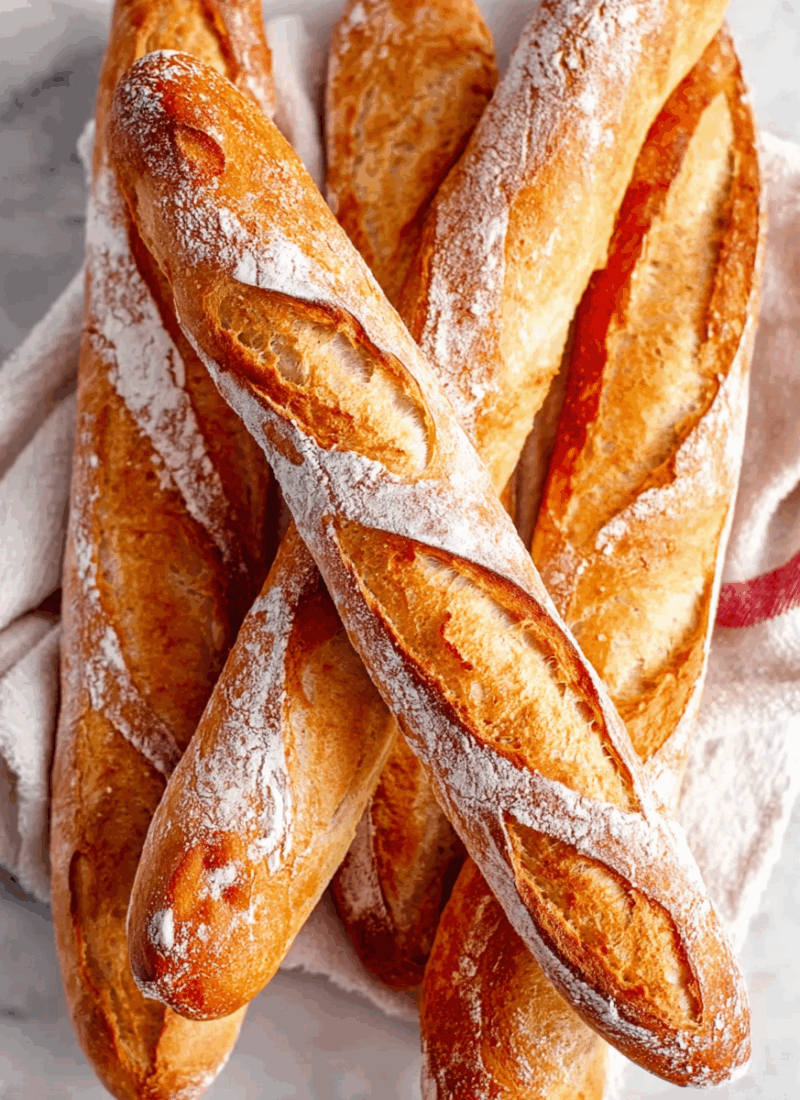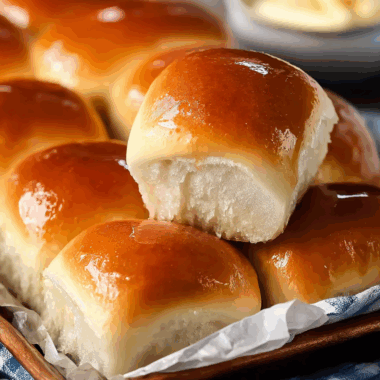Classic French baguettes are a timeless favorite, renowned for their crunchy golden crust and soft, chewy interior. With only four ingredients—bread flour, salt, yeast, and water—this recipe proves that simplicity often leads to perfection. While the process takes time, it’s entirely worth it. The key to these baguettes is in the folding technique, resting periods, and creating steam in the oven for the perfect crust. Bake these up for a truly authentic French experience right in your own kitchen!
Full Recipe:
Ingredients
-
1 cup water
-
1/2 cup lukewarm water
-
2 tsp active dry yeast
-
3 1/2 cups bread flour
-
2 tsp kosher salt
Directions
-
Prepare the Yeast: In a large bowl, combine the 1/2 cup lukewarm water with yeast. Let it sit for 10-15 minutes until the mixture becomes foamy.
-
Mix the Dough: Stir in the flour and salt to the yeast mixture. Add the remaining 1 cup of water and mix until a sticky dough forms. Cover with a towel and let it rest for 45 minutes.
-
Folding Process: For the next 3 hours, fold the dough four times. Wet your hands with water and gently stretch one side of the dough, fold it over, turn the bowl, and repeat on all four sides. Let the dough rest for 45 minutes after each folding.
-
Shape the Dough: After the fourth resting period, turn the dough out onto a floured surface. Cut the dough into 4 equal pieces, shaping each into a rectangle. Let rest for 10 minutes before folding each rectangle lengthwise and rolling into a log about 15 inches long. Pinch the ends to form a baguette shape.
-
Final Resting: Place the shaped baguettes on a floured towel (baker’s couche). Allow them to rest for another 30 minutes.
-
Prepare for Baking: Preheat your oven to 450°F (230°C). Place a pan of boiling water on the bottom rack of the oven to create steam. Line a baking sheet with parchment paper.
-
Bake the Baguettes: Carefully transfer the baguettes to the prepared baking sheet. Score the tops with 4-5 overlapping slashes. Spray the baguettes and oven with water to increase steam. Bake for 16-18 minutes, rotating the tray halfway, until golden brown and the bottoms sound hollow when tapped.
-
Cool and Serve: Let the baguettes cool on a wire rack. Slice and enjoy the perfect French baguette!
Nutrients (approximate per serving, assuming 4 baguettes)
-
Calories: ~200-250 per slice
-
Fat: 0.5 g
-
Carbohydrates: 45 g
-
Protein: 7 g
-
Fiber: 2 g
-
Sodium: 400 mg
The Simplicity of Ingredients and Their Role in the Recipe
Despite its short list of ingredients, a perfect French baguette relies on the quality of the basic components and their precise handling during the preparation process.
-
Bread Flour: Bread flour is the foundation of any good baguette. It has a higher protein content than all-purpose flour, which is key for developing the gluten necessary for the bread’s chewy texture. The strong gluten network traps the gases produced by the yeast, helping the dough rise and giving the baguette its signature texture.
-
Water: The water in the recipe hydrates the flour, allowing the yeast to work effectively. The amount of water and its temperature must be carefully controlled to ensure the dough is not too sticky or dry. Lukewarm water is ideal for activating the yeast without killing it.
-
Yeast: Active dry yeast is used to ferment the dough. This yeast works by consuming the sugars in the flour and producing carbon dioxide gas, which makes the dough rise and gives the bread its light and airy structure.
-
Salt: Salt does more than just flavor the dough—it also strengthens the gluten network and slows down the yeast’s activity, which helps to develop the baguette’s texture. It also balances the sweetness from the flour, creating a more nuanced flavor.
Each ingredient plays an essential role in achieving the right texture and flavor in the final product.
The Folding Technique for the Perfect Baguette Texture
One of the secrets to achieving the perfect French baguette is the folding technique, which is a crucial part of the dough’s development. After the initial mix, the dough needs to be folded multiple times during the resting period. This technique involves stretching and folding the dough in a series of motions that help develop the gluten without overworking the dough.
The folding process works by redistributing the yeast and flour throughout the dough, giving it more structure and allowing it to rise evenly. This technique also helps create the air pockets inside the baguette that give it its characteristic chewy, airy texture. For the best results, the dough should be folded every 45 minutes for a total of four times over the course of about 3 hours.
By wetting your hands and gently stretching one side of the dough, you avoid tearing it, which would otherwise disrupt the dough’s structure. The goal is to create tension on the surface of the dough, which helps it rise more effectively during the final stages of baking.
Resting the Dough for Maximum Flavor
While the folding process is important for achieving the right texture, resting the dough is equally essential. During each rest period, the dough relaxes, allowing the gluten to form properly. This time is crucial for developing flavor as well. As the dough rests, the yeast continues to work, slowly fermenting and breaking down the starches in the flour. This fermentation process produces organic acids that enhance the flavor of the baguette and contribute to its unique tang.
Resting also helps to ensure that the baguette has the right texture—soft on the inside and crusty on the outside. If the dough isn’t given enough time to rise, the result will be a denser, less flavorful baguette.
Shaping the Dough for Traditional Baguette Form
Once the dough has been folded and rested, it’s time to shape it into its traditional baguette form. This is done by cutting the dough into 4 equal pieces, each of which will be shaped into a long log. After the dough is shaped into the log, it is folded lengthwise, pinching the ends together to form the signature tapered shape of a baguette.
It’s important to let the shaped dough rest for an additional 30 minutes on a floured towel or baker’s couche. This final resting period allows the dough to rise again slightly, which helps to create a light and airy texture. Additionally, it’s important to ensure the dough is not overworked during the shaping process to maintain its elasticity and softness.
Creating Steam for the Perfect Crust
The key to achieving that signature crispy, golden crust is steam. When baking a French baguette, it’s essential to create steam in the oven, which helps the dough retain moisture during the initial stages of baking. This steam is responsible for the shiny, crunchy exterior that is so characteristic of the perfect baguette.
To create steam, place a pan of boiling water on the bottom rack of the oven. When you place the baguettes in the oven, the steam helps to create a slight humidity in the air, which allows the dough to expand without the crust forming too quickly. This gives the baguette a chance to rise fully and ensures the final product has the light, airy crumb inside. Additionally, spraying the baguettes and the oven with water just before baking increases the steam, helping to achieve that perfect crust.
Baking and Cooling the Baguettes
Baking French baguettes at a high temperature—450°F (230°C)—is necessary for achieving the golden-brown crust. The high heat ensures that the crust crisps up quickly, while the inside remains soft and chewy. The baguettes should be baked for 16-18 minutes, rotating the tray halfway through to ensure even baking. When done, the baguettes should sound hollow when tapped on the bottom, which is a sign that they are properly baked.
After removing the baguettes from the oven, allow them to cool on a wire rack. The cooling process is essential to setting the structure of the bread, and it also allows the interior crumb to solidify. Slicing the baguettes too early will result in a gummy texture, so patience is key.
Serving and Enjoying Your Baguettes
Once your baguettes have cooled, they’re ready to be sliced and served. Freshly baked French baguettes can be enjoyed in a variety of ways—whether it’s simply paired with butter, cheese, or jam, or used for sandwiches, soups, or stews. The versatility of a good baguette makes it an essential addition to any meal.
One of the best ways to enjoy a baguette is with a bit of creamy butter or a savory spread. You can also use it as a base for bruschetta or crostini, topping it with various ingredients like tomatoes, garlic, or cheeses. The crispy crust and soft interior make it an excellent accompaniment to almost any dish.
Conclusion
Making classic French baguettes at home may seem daunting, but with patience and practice, the results are truly worth it. The simple combination of flour, water, yeast, and salt creates a bread that is much more than the sum of its parts. By following the proper techniques—folding the dough, allowing it to rest, shaping it carefully, and creating steam in the oven—you can achieve the perfect French baguette with a golden crust and a soft, airy interior.
Baking these baguettes brings a taste of France into your kitchen, and once you’ve tasted the warm, freshly baked bread, you’ll understand why it’s considered such a timeless classic. Whether you’re serving them as a side dish, making sandwiches, or simply enjoying a slice with butter, homemade French baguettes are a true delight that elevate any meal.








